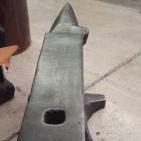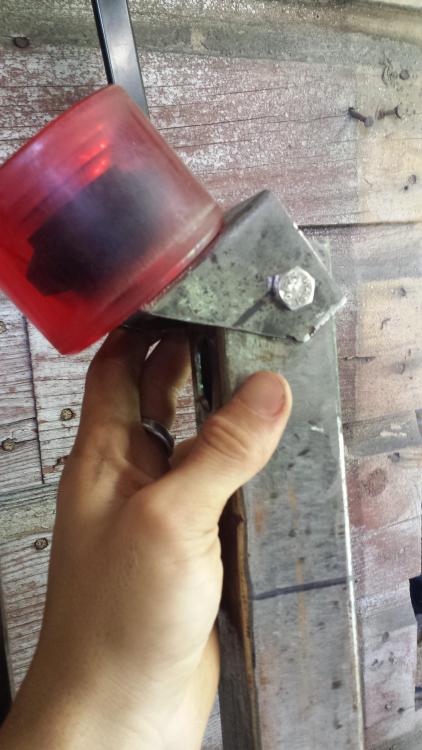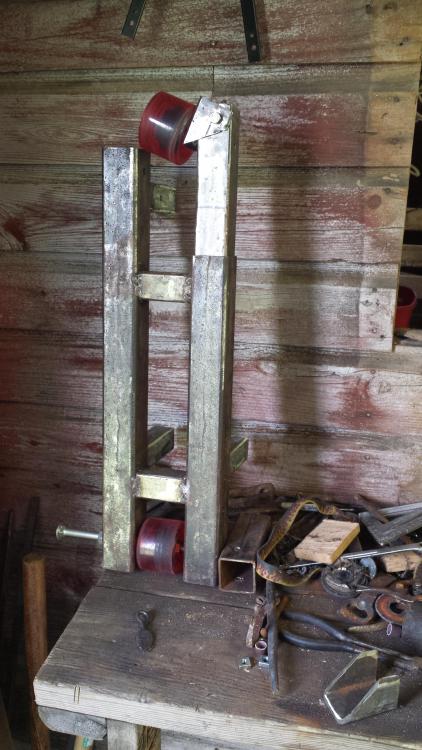-
Posts
124 -
Joined
-
Last visited
Content Type
Profiles
Forums
Articles
Gallery
Downloads
Events
Posts posted by EJRailRoadTrack
-
-
"Art is long. Life is short. Get going!" -Francis Whitaker
And if you want to achieve this "art" thing there's no time to argue with people who don't understand, and don't want too.
Great knife Mark. Just some jerk that can't appreciate the time, effort, materials, and knowledge involved. Atleast you still have the sage block!
-
5 minutes ago, Irondragon Forge & Clay said:
I bought my 2X36 multi grinder like LBS 2X48 from Trick Tools. It works well and the price is right but has limitations. For serious knife grinding I would go with a 2X72 with extra wheels & accessories.
I've seen people put them on larger grinders, put rooling arms on, and rig them up for 2x72 belts. Look pretty solid. I feel like adding more things on it would make it vibrate more, I could be wrong though.

-
7 hours ago, ThomasPowers said:
I got my flyer in the mail a while ago; but they still haven't got the info on their website!
I'm not going to be able to make it. Who am I going to miss?

-
7 hours ago, JHCC said:
This is why "traditional" is practically useless as a description of blacksmithing -- unless you're talking about the tradition of constant innovation and of seeking technical and mechanical improvements to accomplish more in less time!
This is exactly my point. Traditional for a blacksmith is using what's on hand to do the task at hand.
@ThomasPowers yes, a lot of what I see is folks using a forge, anvil, hammer etc, then when they drill holes they use a post drill instead of an electrice drill press and now they are super skilled traditional blacksmith expert. Argh, people.
And if you're going to do it period correct, count me in! One question, is my large attic fan from 1765?
@Frosty exactly blacksmithing isn't something that can be said "this is how it is done and this way only", because everyone has different materials, styles, technology, and preferences!
-
I've been seeing a surge of blacksmiths selling they're work as traditional, which is great, but it begs the question; What is "traditional" blacksmithing?
I personally see blacksmiths as craftsmen and women who use what they have on hand to create something functional, beautiful, or both. Here's where it's tricky. People have been forging for almost as long as there have been people. So really, "traditional" would be hammer, fire, and anvil. Yes? So then 99% of people who forge today are doing it traditionally!
Now let's say that traditional blacksmithing is from 1840-1920. There were a LOT of advances in that 80 year period! Welders, non solid fuel forges, electricity become more redily available, power hammers in more styles then simple water powered trip hammers, and the list goes on. Wouldn't a blacksmith use these advances in his work? And many did. But limiting your work to hammer, anvil and fire then slapping traditional on it makes no sense.
Maybe I'm making no sense. Let me know if I'm not alone or just complaining.
-
1 minute ago, Irondragon Forge & Clay said:
Was wondering about this and if it's feasible to make an anvil stand from reinforced concrete.
That's what power hammers are mounted on. Seems doable.
-
15 minutes ago, littleblacksmith said:
same here, I find it easier to accurately swing a 12lb than a 6lb, and the one person who im friends with who I strike for sometimes looks down on anything under 10. I understand why though, but it is all about preference and what works best and safest for everyone.
Littleblacksmith
And I'm sure I could swing a 12, but I don't like to. I feel being consistent is more important. But yes, Whatever gets it done the safest .
-
14 minutes ago, JHCC said:
@EJRailRoadTrack: no, he's on the autism spectrum with attention deficit, and he was very distracted yesterday. He actually was doing pretty well for a while with the hammer he calls "The Mastadon", which is a 16 lb. Atha stonecutter's maul on a short(ish) handle. (His accuracy is pretty good, and he gets decent striking force with a comparatively gentle swing. He doesn't do as well with a lighter hammer, because it's easier for him to swing windly.) He just hit the wall after about 6-8 heats, and it was safer for everyone to send him back inside.
Oh okay, I see! My mistake. Look forward to seeing how the hammer turns out!
-
@JHCC was he having trouble hitting hard? Accurate? If he was having difficulty with accuracy I would suggest stepping him down to 6 pound sledge with a short (20-22 inch) handle. I always thought I had to swing a 8#. But when someone who came to forge some tools with me brought his 6# with a short handle, I fell in love! Time for me to forge one myself, oh dear, the torture

-
Looks good. Let me know how those wheels work out for you!
-
4 hours ago, AaIma Dauber said:
That is a beautiful monster machine, I love it.
Now, hopefully people are still reading these threads because I need some help, if anyone has the time and patience.....I am needing to build myself a small one of these (power hammer), I have developed arthritis but I do not want to give up what I love. I want to build a small hammer. I have built myself a fine steel belt sander which I use most days, so I am competent when it comes to building and welding etc.
I have a 2 hp motor for the project (which should be sufficient for a small power hammer) and plenty of steel, I am just struggling to figure out which design would be best for me to build. Any advice would be greatly appreciated.
Best regards,
Peter
Knowing what you wanted to forge would really help. The power I would need may be different from the one you need or the one the next my need.
The Ray Clontz/Clay Spencer ture hammer is a good size and it has good control.
-
Oooh, That Damascus keyfob is sweet!!
-
But at the same time, look at your cold cut. Is it ground the same as your hot cut? What's the difference between the two?
I think his point is that ONE AXE will do everything, but each axe is very finely detailed to do it's designed task the best it can.
-
I assume since you said you wanted it the same as your anvil that you are only going to use it for hardy tools? Yes no?
Personally I would trade the plow for some fork lift tine OR sell it and buy some.
Traditional striking anvil:
Portable hole:
I'm sure it could be done, but I would use different materials. Little info as to what you will be making would help too!
-
I did the same thing the other day!
But all that happened was that I found out the inside of my respirator tastes really weird. And no, I'm not going to tell the story..
-
There's been some community testing and it seems there's a seller on "AliExpress" that sells decent contact wheels of different sizes for a decent price.
-
-
Looks amazing! What is the poundage on your struts?
-
Whatever floats your boat, or sinks it in our case, or turns your shoe, OR keeps your anvil in the stand.
I started with my horn on the left, then went right, but yesterday I was in a corkscrew forging contest and the horn was on the left, and I liked it. It somewhat depends on your shop layout and flow as well too.
It's something that will go round and round. But it's just what you like and what you do.

-
28 minutes ago, Ranchmanben said:
Out of curiosity, are you a south paw?
He just has good taste in anvil direction

-
What did you quench the 4340 in? I would use 4340, but it seems like it would take to much oil the quench it.
Looks really good though! I like using square rounding hammers.
-
I got mjne off if Amazon, I'm going almost a year with my brush, everything I forge gets brushed. 90% of the bristles are still in. I just have to brush in one directions only.
-
So are we able to come and visit again? I keep hearing of a blacksmith shop in Doniphan that is like a meeting every weekend. I'm I at all hearing correct?
-
First off, like Jeremy said, a treadle hammer is NOT a power hammer. It will take some work off your arms but it's by no means a power hammer. I'm not sure how long you guys have been forging, but you will learn to swing a hammer better, faster, harder etc. After a not to long amount of time, you will be able to move faster and more efficiently on most steel sizes by hand hammer and anvil than on a treadle hammer.
If we knew what design you thought you wanted to work off we would also be able to help you much better. As some treadle hammers can converted over to air in less then 10 minutes, then back a treadle hammer in the amount of time. buying plans would be great in my opinion, many guys that sell you plans would be willing to help you if you are having trouble with something, and may go back to fix something later on and need those same plans. Buying the plans to have the material cut lengths would save you the money many time over if you miss cut a large expensive piece of steel.
Let us know how you get on!




Chinese Hammers
in Power Hammers, Treadle Hammers, Olivers
Posted
We should meet up when you get it in
In all seriousness I think i'm only about 1.5hrs from you..